The Dissociated Press: An Antique Adventure
February 1, 2011
Eli Goldberg ’12
When it comes to Winter Term, Oberlin students split neatly into two camps. For some, Winter Term exists in large part as a convenient excuse to avoid Midwestern snow. The minute January hits, they're gone: studying Spanish in Mexico, photographing the streets of San Diego, living on kibbutzim. They make it back to campus at the last possible minute before the spring semester starts, with countless stories and enviable tans.
I belong to the second camp, which holds that Oberlin is a great place during the semester, but during Winter Term it's amazing. During three consecutive Oberlin Januaries, I've come to love the peace and quiet of Snowberlin's campus and the coziness of long evenings with friends, no homework in sight. With the pressures of credits and grades gone, the days are packed with things and people I love: playing ukulele, reading and writing poetry, braving the weight room with a crew of gym buddies, making bread for Harkness, vengeful Scrabble tournaments, and crocheting my way through episode after episode of Doctor Who. After a semester abroad, I couldn't stand the thought of another month away; Winter Term Oberlin is exactly where I wanted to be.
With all the joys of being back on campus, it would be easy to forget that I actually have Winter Term work -- except that I have truly the most splendid project ever. To paraphrase Mark Strand, there is no happiness like mine. I have been typesetting poetry.
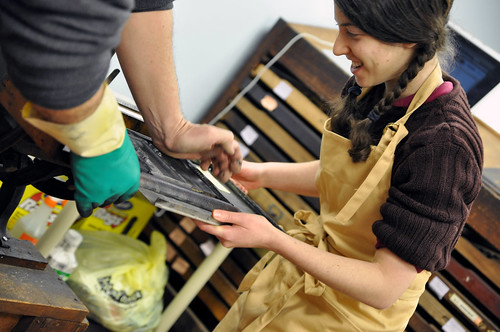
I'm one of ten students learning to handle the antique presses in Oberlin's newly-created letterpress studio. For three and a half weeks, we've slipped into an archaic apprenticeship system and become printer's devils. We run around in aprons, carrying galley trays, hands perpetually covered in ink. Our arms ache from pulling levers, our legs are sore from pumping treadles. We can proofread paragraphs upside-down and backwards, and sort eight-point type in the mysterious order of the California Job Case. We know all too well what it means to "mind your p's and q's," or to "get all out of sorts." We rejoice at the smell of ink and the feel of a deep, clean impression on a sheet of fine paper. Bad typography makes us cringe.
The letterpress lab is the brainchild of Ed Vermue, Oberlin's special collections librarian. Ed's passion for books reminds me most nearly of Mr. Ollivander's passion for wands: he seems to have an encyclopedic memory of every rare book in Oberlin's libraries, and he's full of fascinating trivia about papermaking, binding techniques, and the history of the printed word. I don't know how long Ed's been dreaming of putting together a letterpress at Oberlin, but there's no question that none of this would have happened without him. The press equipment itself comes from all over, but the bulk of it was inherited from an old printer's studio near Dayton, in all its glory: old advertising dingbats, templates for church calendars and high school report cards, and blocks of type all set and tied up, ready to be printed. Ed packed it all up, drove it to Oberlin, and found it a home in a former computer lab on the second floor of the library, with giant windows to distract studying students and curious guests. (For a while there was still lettering on the door that said "Mac Lab," which was wonderfully anachronistic.)
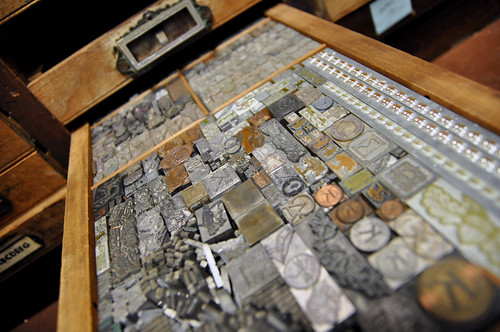
Thanks to Ed's network of crafters and bibliophiles, we've had the pleasure of working with some amazing artists, both as teachers and as collaborators. Bob Kelemen was our letterpress master, teaching us everything from the fundamentals of design ("Free typefaces on the Internet are like free gum that you find stuck under a table") to the subtle physics of locking up type on the press. Claudio Orso gave us a bombastic and inspiring introduction to the art of woodblock carving ("I can be your midwife-cheerleader, but you need to give me a baby to deliver! And remember: even if you think you can't draw, there is no one else in the world who can not-draw the way you can.") David Young, the editor of Oberlin College Press, introduced us to the joys and challenges of working at a small literary press.
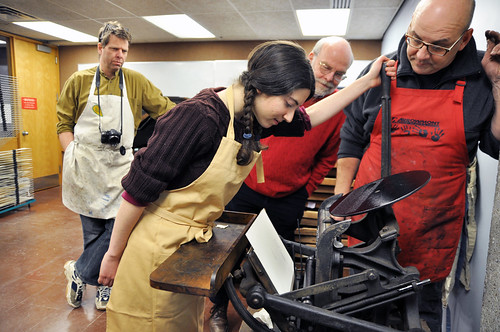
After a week and a half of experimentation, we finally met the person who would make our ultimate project possible: Sarah Green, an Oberlin alum and accomplished writer. It was our responsibility to print a chapbook containing a dozen of Sarah's poems. Clustered around a conference-room table deep in the bowels of Mudd, Sarah read us her poems -- the first time we'd heard or seen her work. Immediately, we began to consider the challenges of designing, editing, and printing: what order should the poems go in? What would the book be called? Would there be illustrations? How should the cover look? What typefaces would we use? Every detail, from the book size to the page numbers, needed to be planned perfectly before we could print a single word. Suddenly we weren't just messing around with dingbats: we were creating a home for Sarah's poetry, from start to finish.

As the first group to use the letterpress studio, we've run into a few obstacles. Some were minor: for example, turns out the stuff we first got to clean the presses didn't quite work. (For the record, vegetable oil works wonders on inky rollers.) Others were more substantial: we didn't have enough type to set an entire four-page spread, doubling our printing time. Surprisingly enough, the biggest challenge was picking a name for our press. In a marathon brainstorming session, we came up with a long list of irreverent names: The Dissociated Press, O!Press, Snow Day Press. Our supervisors wanted something a little more serious, and decided on The Letterpress At Oberlin. We dubbed our little group the First Pass Collaborative: the first printing, the trial run, the guinea pigs.

Inside the letterpress lab, towers of type frame three presses. The largest, the Vandercook, hums gently as its rollers distribute ink. (The inking mechanism is the only motorized thing in the room, and it's not essential - in a power outage, we could print by candlelight.) On the bed of the press, rows of hand-set letters are framed by strips of wood and metal, locked in so tight that not even the tiniest comma will wiggle. Stacks of fine paper - spotless, trimmed exactly to size - wait on carts lined neatly with newsprint. A designated "clean hands person" lifts each sheet and bears it to the press operator, who aligns it laboriously and clips it to the barrel of the press. The rest of the clean hands crew, gathered at the other end of the press, wait reverently as the operator pulls the crank and the barrel begins to turn. As the printed sheet emerges, they catch it as tenderly as a newborn and sweep it away to the drying rack.
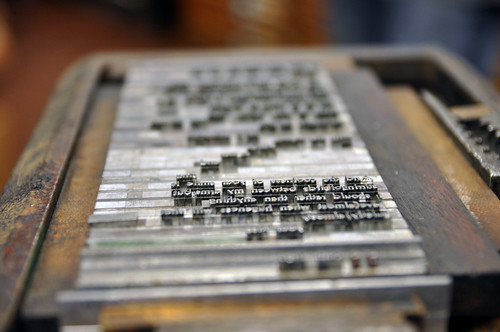
Working with a computer and laser printer, one of these pages might take fifteen minutes to create. On a letterpress, it may take a full day to set the type, lock it up on the press bed, ink up the press, proof everything, correct any mistakes, ensure that everything is printing neatly, and finally print all the copies we need. That's not counting the time we spend thinking about design, experimenting with layout, finding the right typeface, and designing and cutting woodblock illustrations. Our final project - one hundred and forty copies of a sixteen-page poetry chapbook - will take more than three weeks from start to finish.
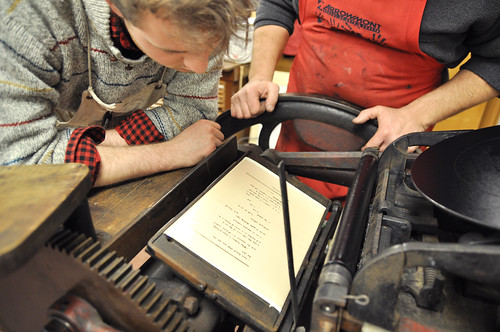
This is not the kind of thing you do as a quick, fun project (although it is undeniably fun). You do it because you love the written word and you are committed to creating a unique and beautiful thing, no matter how long it takes. During the semester, I live in a world where books are things you mine for tidbits to support an argument, and papers get pounded out in Times New Roman to meet a seminar deadline. In the letterpress studio, each word is a labor of love, and every page that comes off the press is a fresh new miracle. When else could I do something like this, if not during Winter Term?

All of the photos in this post were taken by Ma'ayan -- to see her entire album of letterpress photos, click here!
Tags:
Similar Blog Entries

Do You Know Exactly Where Your Fingers Are??
February 9, 2024

Kosher-Halal Co-op Is Back, Baby!
February 7, 2024
